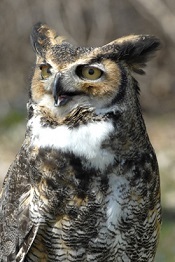DEC Staff Sampling for Moose Across the Adirondacks
 The moose (Alces alces) is the largest member of the deer family and the largest land mammal in New York State. DEC staff, in collaboration with other groups, are currently conducting aerial distance sampling for moose across the Adirondacks. During this multi-year research project, the team will obtain information on the status of New York State's moose population, health of the moose, and factors that influence moose survival and reproduction. As part of the study, twelve moose were captured in the Adirondacks in January 2015, fitted with GPS radio collars, and released. Another nine moose were captured in January 2016 and five more were captured in 2017. The movement of the moose are being remotely tracked. The goal of the Adirondack moose study is to create a moose management plan for New York State based on the data they collect. The moose (Alces alces) is the largest member of the deer family and the largest land mammal in New York State. DEC staff, in collaboration with other groups, are currently conducting aerial distance sampling for moose across the Adirondacks. During this multi-year research project, the team will obtain information on the status of New York State's moose population, health of the moose, and factors that influence moose survival and reproduction. As part of the study, twelve moose were captured in the Adirondacks in January 2015, fitted with GPS radio collars, and released. Another nine moose were captured in January 2016 and five more were captured in 2017. The movement of the moose are being remotely tracked. The goal of the Adirondack moose study is to create a moose management plan for New York State based on the data they collect.
If you see a moose in NY, please fill out a moose sighting report.
Watchable Wildlife: Great Horned Owl
 Now may be a good time to see great horned owls (Bubo virginianus). They are year-round residents, but start sitting in their nests as early as January or February. Great horned owls are large birds (adults can be 18-25 inches in length) and have large ear tufts on their head and large yellow eyes. Their feathers are usually a mix of colors: white, reddish-brown, gray, and black with a white patch on their throats. Now may be a good time to see great horned owls (Bubo virginianus). They are year-round residents, but start sitting in their nests as early as January or February. Great horned owls are large birds (adults can be 18-25 inches in length) and have large ear tufts on their head and large yellow eyes. Their feathers are usually a mix of colors: white, reddish-brown, gray, and black with a white patch on their throats.
Great horned owls can be found throughout New York state in a variety of habitats, such as forests or fields, near cliffs, and even around suburban or urban areas. They are most active at night, especially dusk and dawn, but sometimes hunt during the day. Listen for their distinctive “hoo-hoo-hoo-hoo” call.
Photo by Susan L. Shafer
|


 The
The  Now may be a good time to see
Now may be a good time to see